Chess fever, Dr. Grigoryev and the Sons of Lothar Schmid
(Click here for a Dutch version of
this text, somewhat less extensive, but with text fragments from
The Twelve Chairs translated into Dutch.)
Ostap Bender was good at many things. He was a great psychologist, with a
unique understanding of his fellow men.
He was also very practical and resourceful. And he was good with words: he wrote
film scenarios and provided a professional journalist with a vocabulary for
writing ideologically correct articles about Central Asia and the Turksib.
One thing we know Bender was not good at was drawing. The other is
playing chess.
When we think of Ilf and Petrov and chess the Vasyuki chapter is of course the
first thing that comes to mind. It is one of the funniest chapters of their
novels. But it is not all Ilf and Petrov have to offer, chesswise.
The chess background is one of the few fields, if not the only one, where I
think Mr Shcheglov's commentary in his Спутник читателя
leaves something to be desired. Even the
Odessky and Feldman edition, with its much, much less extensive commentary,
has more to offer here. But they leave much unexplained as well.
(See the bibliographical
page for more information.)
Being a chess player myself,
I thought it would be interesting to provide some additional chess
background to the chess references - in particular the Vasyuki chapter of course
-
mentioned in the works
of Ilf and Petrov. At the end of this chapter, moreover, I will present
some examples of Ilf and Petrov references
in the chess world.
There will be quite a few references to chess games which you can play through.
They may be interesting for people who know at least the rules of chess. Just
click the link to go to the page with the referred game.
The Twelve Chairs
Other chess references in the work of Ilf and Petrov
References to Ilf and Petrov in the chess world
The Twelve Chairs
First I will sketch in general what the chess world of the Soviet-Union anno
1927 looked like.
For this section I owe much to Andrew Soltis' book Soviet Chess 1917-1991,
which I
can wholeheartedly recommend to anyone interested in the history of chess.
In the beginning of the Twenties, after the Civil War, chess life was virtually
non-existent, just like
the rest of cultural life. Of the 18 players who competed in the all-Russian
Tournament of 1913-1914, only six remained in the Soviet Union after 1920.
Gradually the government started to stimulate the formation of chess
sections and chess clubs. From 1924 onward Nikolay Krylenko, about whom I will
say a few words later on, was a central figure
in this process.
Internationally
the country still played a modest role.
The most important Russian player of those years was Alexander Alekhine (I
will use the most common - French - spelling of his name). He had lived in Moscow
before World War I and the Revolution, but he then left the city in search of a
chess income. Interestingly, he was in Odessa in 1919, when Ilf and Petrov also
still lived there. He was arrested by the Cheka and somehow escaped the firing squad.
He was given a government job when the Reds still had the power in Odessa but
left again for Moscow before the White general Denikin took over. He remained
suspect to the Revolutionary authorities, was interrogated a second time, but
again got away with it and in 1921 received permission to leave the country. According
to Karl Radek,
one of the most famous victims of the later Purges, his chess genius could only
be developed outside of Russia. However, it was only much later that he was
forgiven his desertion and became a chess icon in Russia.
Efim Bogoljubow (German spelling) had been interned in Mannheim at the beginning
of World War I. He was invited for the Soviet championship of 1924. He took part,
and lived in the Soviet-Union until 1926, when he emigrated to Germany. Not so
much for political as for financial reasons, so it seems.
Aron Nimzowitsch,
another very strong player of the period, was born in Riga, which then, in 1886,
belonged to the Russian empire, but soon after the Revolution he managed
to get away and no one even thinks of him as a Russian.
Saviely Tartakower was
also born on Russian soil, but he was son of Austrian parents and later became a French
and Polish citizen. When Akiba Rubinstein was born, his native Poland
belonged to Russia, but after Polish independence he lived in Poland and
he has never been regarded as an (ex-) Russian.
Very important for Soviet chess and also for the chess in The Twelve
Chairs was the Moscow 1925 Tournament. It was the first large
tournament to be arranged on government funds. The tournament was very strong
and aroused
much interest in the country and abroad. Vsevolod Pudovkin, who was to become
one of the most important film directors in the Soviet-Union, made a short
film comedy, Chess Fever ('Шахматная горячка' in Russian), featuring
images of the tournament. Capablanca plays a small role in the story, charming
the heroine into liking chess. You can find the film on YouTube, and it is well worth watching.
(In this movie, incidentally, there is a blind beggar who is not really
blind. One cannot help thinking of Panikovsky.)
The chess fever really existed. Soltis writes:
"Men's ties, cuff-links, shirts, or any article of clothing, in fact, that had
a chess design was suddenly fashionable".
According to Soltis, the chess fever was caused in particular by
Ilyin-Zhenevsky's
victory over world champion Capablanca,
who had a very promising attack which
proved not so easy and was subjected to a violent counter attack by the
Soviet-Russian.
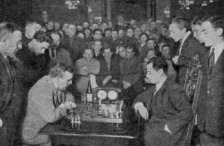
|
World champion Capablanca (on the right) versus Bogoljubow in Moscow 1925 |
Alexander Alekhine, then possibly already the strongest player in the world, was absent, still being regarded as a traitor in the Soviet chess world because he had left the country. His win against Reti in the Baden-Baden tournament of the same year contains one of the most famous combinations, or rather 'combination symphonies', in chess history. in this game.
Now let us look at the chess content of The Twelve Chairs.
In the chapter 'Знойная женщина, мечта поэта' we learn that Ostap is wearing 'шахматные носки', 'chess socks', which in Russian would normally be called 'клечатые носки' and in English 'checkered socks', referring to the game of checkers instead of chess.
On the other hand, this may also be a reference to the 'chess fever' of 1925, mentioned above: they could have been real chess socks.
Avessalom Vladimirovich Iznurenkov is described as being as great a master in his art (producing newspaper jokes) as Shalyapin in singing, Gorky in literature and Capablanca in chess. In 1927, when Ilf and Petrov wrote The Twelve Chairs and also the year in which the novel is situated, Capablanca played a world championship match with Alexander Alekhine, and lost it. So when the authors wrote this, Capablanca was still world champion, but when the book was published, Alekhine had taken over the throne. In the final game of their match Alekhine beat Capablanca in a long ending, where the ending had always been Capablanca's strong point.
Maestro Sudeykin and the Stanok
Very interesting from a chess point of view is the chapter 'Клуб автомобилистов', in which the activities of the Stanok newspaper are described.
Первым к секретарю редакции прибежал заведующий шахматным отделом маэстро Судейкин. Он задал вежлывый, но полный горечи вопрос.
- Как? Сегодня не будет шахмат?
- Не вмещаются - ответил секретарь, - подвал большой. Триста строк.
- Но ведь сегодня же суббота. Читатель ждет воскресного отдела. У меня ответы на задачи, у меня прелестный этюд Неунывако, у меня, наконец...
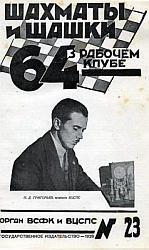
|
Nikolay Grigoryev on the cover of the chess and checkers journal 64 |
Later I will return to the question whether Grigoryev was really the model for Sudeykin, but here I will say a few words about Grigoryev, whom we will meet later anyway.
The commentaries I have seen only mention Grigoryev as organizer and chess journalist (his column in Izvestia, started in 1922, was the first important chess column in the Soviet-Union), but as I said before, he was a strong player. In 1919 he won a match against Ilyin-Zhenevsky by 5-0. (Yet Ilyin-Zhenevsky played in Moscow 1925 and Grigoryev did not.) Soltis' book gives one of the games of this match. (Concluding with a not too difficult pawn ending - see below.) It was the first important chess event after the Revolution, played in very harsh conditions, in the winter and without firewood. Grigoryev won the Moscow city championship three times in the early Twenties.
Back to the fragment about Sudeykin.
Let me first explain what an этюд is. In English it is called 'study' or 'endgame study'. It is a task of the type 'white to play and win' or 'white to play and draw'. The position is 'composed', it is not taken from a game that was really played. That means that every piece and pawn has a function, they cannot be there 'just like that'. Usually there are not many pieces on the board, therefore they are sometimes called 'endgame studies': the positions sometimes look like endgame positions from real games, but they are always artificial constructions. Interestingly, Dr. Grigoryev is known in the chess world above all as an endgame study composer, specialising in pawn endings. He has created true gems in this field. If you know the chess rules, do yourself a favour and look at this brilliant Grigoryev study.
Studies are not to be confused with 'задачи', 'problems' in English. A problem is usually a task of the type 'white to play and mate in x moves'. Problems are also artificial compositions, not positions from real games. However, whereas studies can end in, for instance, the win of a rook, after which the further win of the game is clear, in problems this is irrelevant. Only mate counts. Problem positions usually look far more artificial than those of studies.
Neunyvako really existed. He was a composer of both chess problems and endgame studies. I found an interesting article about Neunyvako (in Russian, opens in new window). Apparently he beat Capablanca in 1925 in a simultaneous exhibition. In the article Neunyvako is described as an important study composer, but I rather doubt that. He is not in my chess encyclopedia, he is not in Wikipedia, and the largest known database of endgame studies (collected by Harold van der Heijden) contains only one of his works, where he is only co-author. I did find one study of Neunyvako on the internet, on a site about chess history in Kharkiv and St. Petersburg (which also bluntly states that Duz-Khotimirsky and not Grigoryev is the prototype for Maestro Sudeykin). Maybe Neunyvako was more important as a problem composer, but then it is a bit strange that Sudeykin had selected an endgame study of his, rather than a study. So why did Ilf and Petrov choose Neunyvako and not another composer? My guess is that it was because of his rather funny, Ilf-and-Petrov-like name.
See for more information on Grigoryev this interesting article (in Russian, opens in new window).
Back to Sudeykin and his struggle for lines in the Stanok:
Маэстро пытался было вымолить еще строк тридцать хотя бы на этюд Неунывако (замечательная индийская партия Тартаковер-Боголюбов лежала у него уже больше месяца), но его оттеснили.
What game are Ilf and Petrov referring to? Full of hope I searched the games played between Tartakower and Bogoljubow before 1928, but none of them was an 'Indian' game, i.e. a game with an Indian opening (see for more information my comments to the Vasyuki chapter). Odessky and Feldman without further motivation suggest that a game from the New York 1924 tournament is referred to, but the two games they played there are hardly worth publishing, let alone 'remarkable'. I did find a remarkable game between Tartakower and Bogoljubow from 1927 though.
Маэстро Судейкин уже не боролся за прелестный этюд
Неунывако. Он тщился сохранить хотя бы решение задач. После борьбы, более напряженной, чем борьба его с Ласкером на сен-себастианском
турнире, маэстро отвоевал себе местечко за счет "Суда и быта".
Interestingly, the original authors' version of the novel has Capablanca instead of Lasker
in this fragment.
Before 1927 two important tournaments were held in the Spanish town of San Sebastian,
in 1911 and 1912. Lasker played in neither of them. Capablanca played in 1911,
but Grigoryev, nor any other later Soviet player, played in either of them. In
1924 Lasker visited Petrograd and Moscow and in Moscow he played a game
against Grigoryev. Lasker won. Unfortunately this game is not in the databases.
I did find
one game between Grigoryev and Capablanca. It was played in 1914 in Moscow. It must
have been some kind of exhibition or training game, because there was no
tournament in Moscow that year. Both Capablanca and Lasker played a mini-match
with Ossip Bernstein, another fairly strong Russian who managed to escape the
Bolsheviks.
The game Capablanca-Grigoryev was remarkable, if not very tense. After a calm
opening and some exchanges the game looked very drawish. Then Capablanca
sacrificed or lost a pawn and subsequently quickly outplayed Grigoryev in a
rook ending - a specialty of Capablanca. It is very uncertain whether Ilf and
Petrov meant this very game, but I will present it anyway:
Capablanca-Grigoryev, Moscow 1914
This is a good moment, however, for me to defend my opinion that Fyodor Duz-Khotimirsky was
the model for Sudeykin, rather than Dr. Grigoryev.
1. Fyodor Duz-Khotimirsky was the chess man at Gudok in Ilf and Petrov's
time. In Воспоминания о Юрии Олеше I. Ovchinnikov writes:
"На четвертой странице "Гудка" печатался шахматный отдел. Вел его наш старейший
мастер-перворазрядник Ф. И. Дуз-Хотимирский.
Как только добродушнейший Федор Иванович появлялся в нашей комнате, он сейчас же
попадал в плен к гудковским шахматистам: давал сеансы одновременной игры, помогал
решать шахматные головоломки, становился душой блиц-турниров."
I think this connects well with the image of Maestro Sudeykin in The Twelve
Chairs.
2. In the 'deleted scene' given below in the section on Vasyuki, the authors
call him 'maestro Duz-Khotimirsky', analogously to 'maestro Sudeykin'.
3. In 1909
Duz-Khotimirsky beat world champion Lasker in a magnificent game
in the strong St. Petersburg tournament. This really was a tense struggle
and this may have been the game Ilf and Petrov were referring to in the fragment
above. After all,
he won this fight, just as he won the fight for space in Stanok (if
only for the time being). Duz-Khotimirsky never
beat Capablanca. In the Moscow 1925 tournament
he lost to him in a game
that would earn the third brilliancy price.
The sound department of the Columbus Theatre
Among the staff of the Columbus Theatre are the following men:
Звуковое оформление - Галкина, Палкина, Малкина, Чалкина и Залкинда.
Lazar Zalkind (1886-1945) was like Grigoryev a composer of endgame studies. In
1922-1929 he wrote for the endgame department of the Moscow-based journal
Shakhmaty. I do not know whether Ilf and/or Petrov knew him personally,
but being interested in chess it is highly probable that they knew his name. He was
an important composer; the studies I have seen are elegant and easy to understand.
Look, for instance, at
this stalemate study.
Viktor Malkin was a friend of Mikhail Botvinnik's
and a chess writer, and more or less
a contemporary of Ilf and Petrov. However, whereas I am pretty sure that our
heroes knew Lazar Zalkind, at least by name, the connection with Viktor Malkin
is rather obscure.
The interplanetary chess congress
In the beginning of his conversation with the Vasyuki chess players, Ostap says:
- Проездом в Казань, - говорил Остап отрывисто, - да, да, сеанс сегодня
вечером, приходите. А сейчас, простите, не в форме, устал после Карлсбадского турнира.
A dangerous start of Ostap's 'combination'. Was he aware that there had not
been a tournament in Carlsbad that year? There
had been a strong tournament there in 1923 for the last time.
Вы знаете, Ласкер дошел до пошлых вещей, с ним стало невозможно играть.
Он обкуривает своих противников сигарами. И нарочно курит дешевые, чтобы дым
противней был. Шахматный мир в беспокойстве.
In Time Magazine of 14 March 1927 there was an article about Lasker and
his cigars. It
begins as follows:
"The traditionally quiet atmosphere of international chess had been disturbed.
One M. L. Lederer had accused Dr. Emanuel Lasker, German chess master, onetime
world's champion, of employing unfair tactics for the purpose of impairing his
opponents' powers to cerebrate. Specifically, Mr. Lederer had charged Dr.
Lasker with 1) smoking cigars of semi-lethal composition during his matches,
2) exhaling fumes of same at strategic intervals and with unnecessary force,
3) shouting superfluous orders at attendants, 4) being a nuisance intentionally."
A remarkable similarity. Did Ilf and/or Petrov read this? Or was there a Moscow
newspaper or magazine which covered this same issue?
Read the entire article (quite amusing).
Назвали бы, например, вашу секцию - "Шахматный клуб четырех коней", или "Красный
эндшпиль", или "Потеря качества при выигрыше темпа". Хорошо было бы! Звучно!
The first proposed name refers to a chess opening: the Four Knights Game,
'Дебют четырёх коней' in Russian. It is certainly not a bad opening, but typically
played by beginners, and rather old fashioned. It is characterised by the moves
1.e4 e5 2.Nf3 Nc6 3.Nc3 Nf6, i.e. both players first play their king's pawn and
then both their knights. In modern years it still occasionally appears at top
grandmaster level. See
Bogoljubow-Gruenfeld
for an example from Moscow 1925
(a convincing win by the tournament winner).
The third proposal, "Потеря качества при выигрыше темпа", has a certain Marxist
ring to it, but the words 'качество' and 'темп' are chess idiom as well.
'Качество' means
the difference in value between a rook and a knight or bishop. In English this is
called 'exchange', which makes the phrase hard to translate because the ambiguity
is lost ('loss of the exchange' has no meaning outside of chess). The same goes, to
a lesser extent for 'выигрыш темпа': the English 'tempo' is not often used
in a 'general' context. In chess it is the 'unit of time'. When you
win a tempo, you win time.
(See the translation page for a more detailed discussion
of this phrase.)
In
Reti-Zubarev we see
a perfect example of the 'principle' described by Bender, used by the Russian
to get active pieces and an extra pawn after sacrificing an exchange, in
the end achieving a draw.
 The ideological context of this name was nicely confirmed in a poster from 1931
with the text: 'большевистские темпы и высокое качество'. You can view the poster
in a larger format
here.
(It is worthwile to browse through the rest of the online exhibition as well.)
The ideological context of this name was nicely confirmed in a poster from 1931
with the text: 'большевистские темпы и высокое качество'. You can view the poster
in a larger format
here.
(It is worthwile to browse through the rest of the online exhibition as well.)
Что вы раньше слышали о городе Земмеринге?
In 1926 an important tournament was held in this Austrian town, won by Rudolf
Spielmann, a strong Austrian who also participated in Moscow in 1925.
Look how
Spielmann beat Nimzowitsch
in a exciting game with attacking and counter-attacking.
Подумайте над тем, как красиво будет звучать - "Международный Васюкинский
турнир 1927 года". Приезд Хозе-Рауля Капабланки, Эммануила Ласкера, Алехина,
Нимцовича, Рети, Рубинштейна, Мароци, Тарраша, Видмара и доктора Григорьева
обеспечен. Кроме того, обеспечено и мое участие!
World champion Capablanca, Lasker, Tartakower, Rubinstein and Reti all played
in the Moscow 1925 tournament. Alekhine, Nimzowitsch, Vidmar, Rubinstein, Tarrasch and Reti played in
Semmering 1926, which Ostap just mentioned. All the players mentioned by Ostap
were world class (though
former world champion Tarrasch was not as strong as he used to be), with
the exception of Grigoryev and of course Bender himself.
(...) австралийские поклонники индийской защиты, индусы в белых тюрбанах -
приверженцы испанской партии, немцы, (...)
The Indian defense (characterised by the moves 1.d4 Nf6) is in fact not a
chess opening but a family of openings which are very diverse. Nowadays nobody
talks about the 'Indian defense' anymore. It is like saying "I love
Russian literature": too general and therefore meaningless. Interestingly, Soltis
tells us that in the beginning of the Twenties new opening systems were reaching
Moscow, particularly the Indian systems, and then cites an
exciting game between
Grigoryev and Duz-Khotimirsky.
The 'Spanish game' is a specific opening: 1.e4 e5 2.Nf3
Nc6 3.Bb5. In English it is usually called the 'Ruy Lopez opening'.
Old but still popular on all levels, including the very highest. As
we will see, Ostap himself also favoured the Spanish opening. But do Indians
favour the Spanish opening, as the punctuation suggests?
Lasker-Romanovsky is an example from Moscow, with a rather
old-fashioned form of the Spanish opening.
Из фешенебельной гостиницы "Проходная пешка" вышел чемпион мира Хозе-Рауль
Капабланка-и-Граупера. Его окружали дамы.
A 'Проходная пешка', in English 'passed pawn', is a pawn whose
promotion enemy
pawns cannot prevent. A passed pawn can be a strong trump, especially in the
ending, as shown by the magnificent ending of
Reti-Romanovsky.
Capablanca was indeed a very handsome man who very much liked the company of
ladies. As such he played a role in the film Chess Fever, which I
mentioned above.
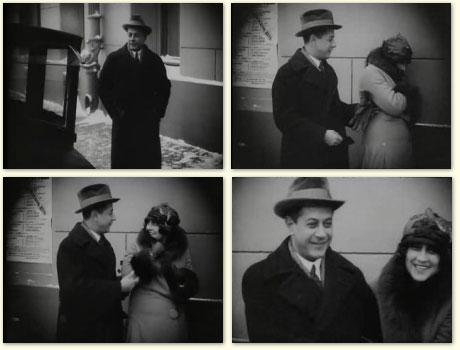
|
I find this passage somehwat mysterious. Why did Alekhine and Grigoryev arrive together? Unlike Grigoryev, Alekhine did not live in Russia at the time. (There is an interesting story around Alekhine and Grigoryev, not connected with this fragment or The Twelve Chairs. Chess players may remember a game between them : after some wild complications in the opening a position arises where Black has two queens and White even three. Alekhine, playing white, won the game by a subtle rook move. Unfortunately, this game was never really played - it was fabricated by Alekhine. Why and how? If you are a chess player, do yourself a great favour and visit Tim Krabbe's Chess Curiosities website).
Capablanca probably frowned because he feared the strong Alekhine, who would indeed beat him in the world championship match of 1927. But why is Alekhine called the future world champion here? Either Alekhine is world champion, or he is not. When he is not, how could the authors be sure that he would be? Is this a last minute insertion by the authors, at some point when the match had already ended?
Я узнаю великого философа-шахматиста, доктора Ласкера.
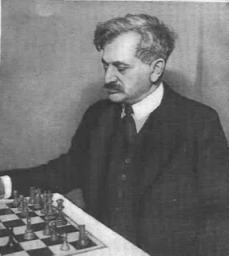
|
Emmanuel Lasker |
Одноглазый взял Ласкера за талию, подвел его к чемпиону и сказал: - Помиритесь! Прошу вас от имени широких васюкинских масс! Помиритесь!
Хозе-Рауль шумно вздохнул и, потрясая руку старого ветерана, сказал: - Я всегда преклонялся перед вашей идеей перевода слона в испанской партии с b5 на c4.
I am not sure whether Lasker and Capablanca were on speaking terms in 1927. They had bad relations during negotiations on their world championship match, which took place in 1921. Thanks to the intricate search function of the chess database program ChessBase I was able to discover the 'bishop from b5 to c4' thing, contrarry to what I wrote earlier. In 1894 Lasker became World Champion by beating Wilhelm Steinitz in a match. The very first game went 1.e4 e5 2.Nf3 Nc6 3.Bb5 (Spanish opening) d6 4.d4 Bd7 5.Nc3 Nge7 6.Bc4, i.e. Lasker played his bishop voluntarily from b5 to c4. A rather queer-looking move, but he won the game. In the third game the opening and the sixth move were repeated and Lasker won again. The fifth game saw the same first six moves, but this time Steinitz managed to draw. And in the ninth game Lasker again played his bishop from b5 to c4 in the Spanish opening, although under somewhat different circumstances. Lasker considered this his best game of the match.
I think this seemingly random thing was carefully chosen by Ilf and Petrov. Firstly the bishop manoeuvre was important because it played a role in Lasker's becoming World Champion. Second, the move is very old and it is rather strange, and by the time of this phantasy Capablanca has taken over the title from Lasker long ago. So the authors may have intended a very subtle element of irony.
In the authors's version of the novel there is a chess related 'deleted scene' here:
Энтузиазм дошел до апогея. Завидя маэстро Дуза-Хотимирского и маэстро Перекатова, плывших над городом в яйцевидном оранжевом дирижабле, одноглазый взмахнул рукой.
Два с половиной миллиона человек в одном воодушевленном порыве запели:
Чудесен шахматный закон и непреложен:
Кто перевес хотя б ничтожный получил
В пространстве, массе, времени, напоре сил
Лишь для того прямой к победе путь возможен.
Fyodor Duz-Khotimirsky, who, as I stated before, may have been the model for Maestro Sudeykin, also played in the Moscow 1925 tournament. He finished 20th (out of 21, only his compatriot Zubarev scored less), which does not mean he was a weak player: in the Fourth Soviet Championship of 1925 he had finished 5th, before, among others, Gotthilf, Ilyin-Zhenevsky, Romanovsky, Rabinovich and Grigoryev. You can observe him being blown away by the American Frank Marshall.
The song is another nice mixture of chess language and propaganda.
And another deleted chess scene (did the editors think that the chess thing was a bit overdone?):
К одноглазому подбежал скороход.
- Смятение на сверхмощной радиостанции. Требуется ваша помощь.
На радиостанции инженеры встретили одноглазого криками:
- Сигналы о бедствии! Сигналы о бедствии!
Одноглазый нахлобучил радионаушники и прислушался.
- Уау! Уау, уау! - неслись отчаянные крики в эфире. - SOS! SOS! SOS! Спасите наши души!
- Кто ты, умоляющий о спасении? - сурово крикнул в эфир одноглазый.
- Я молодой мексиканец! - сообщили воздушные волны. - Спасите мою душу!
- Что вы имеете к шахматному клубу четырех коней?
- Нижайшая просьба!..
- А в чем дело?
- Я молодой мексиканец Торре! Я только что выписался из сумасшедшего дома. Пустите меня на турнир! Пустите меня!
- Ах! Мне так некогда! - ответил одноглазый.
- SOS! SOS! SOS! - заверещал эфир.
- Ну хорошо! Прилетайте уже!
- У меня нет де-е-нег! - донеслось с берегов Мексиканского залива.
- Ох! Уж эти мне молодые шахматисты! - вздохнул одноглазый. - Пошлите за ним уже мотовоздушную дрезину. Пусть едет!
Carlos Torre also participated in the Moscow 1925 tournament. He beat former world champion and runner-up of the tournament in a very famous game: Torre's queen sacrifice is a combination of a very rare kind. Its mechanism is sometimes called by the German name 'Zwickmuehle'. An interesting (though not quite confirmed) story is connected with this game: Lasker had a good position, but someone informed him during the game that a play he had written would be performed. He was so overjoyed to hear this that he lost concentration and allowed Torre to execute his queen sacrifice.
Be that as it may, it was an excellent game by Torre and generally he played several beautiful games in a very good tournament, although at the end he fell back with some defeats.
In 1926 Torre became mentally ill. He never really recovered. Ilf and Petrov's joking about this may have been a reason, or the reason, for the exclusion of this scene from the novel. Some readers, including yours truly, may consider this to be in bad taste.
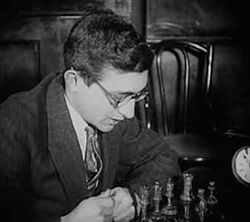
|
Carlos Torre |
Ostap's lecture is compelete nonsense, of course.
А теперь, товарищи, я расскажу вам несколько поучительных историй из практики наших уважаемых гипермодернистов Капабланки, Ласкера и доктора Григорьева.
'Hypermodernism' was a complex of new ideas in chess, mainly about not placing pawns in the centre but trying to provoke weaknesses in the enemy pawn centre and attack it with pieces. The main hypermodernists were considered Nimzowitsch, Reti, Tartakower and Alekhine. In fact, Alekhine's Defence and Reti's opening are the openings most commonly associated with hypermodenism, and in Moscow 1925 these openings were quite common. Reti-Bogoljubow from the Moscow 1925 tournament is a nice example. The players mentioned by Bender were no hypermodernists.
- Гроссмейстер сыграл e2-e4.
Остап не баловал своих противников разнообразием дебютов. На остальных двадцати девяти досках он проделал ту же операцию: перетащил королевскую пешку с e2 на e4.
This already should have made the Vasyuki chess players suspicious. Normally in a simultaneous exhibition the performer chooses different openings, to make the games more diverse and keep them separate in his head, and also to prevent players from imitating each other.
На третьем ходу выяснилось, что гроссмейстер играет восемнадцать испанских партий. В остальных двенадцати черные применили хотя и устаревшую, но довольно верную защиту Филидора.
We can infer from this that all black players played their king's pawn on the first move: 1.e4 e5. Ostap played 2.Nf3 on every board and then most players replied 2...Nc6, to which Ostap played the 'Spanish' move 3.Bb5, and a minority defended their pawn with 2...d6, the Philidor's defense, which is (and was) indeed obsolete and nowadays very rarely played, both on grandmaster level and on club level. In Moscow 1925 it was not played at all. We may conclude that the Vasyuki players were not strong, in any case they did not study modern chess opening theory or tournament games. Take the Semmering 1926, or the Moscow 1925 tournament: after 1.e4 all kinds of openings were played, including the hypermodernist 1...Nf6.
The end
In the tragicomic ending of the novel, it is fitting that the chair which contained the treasure was in the chess corner of the railway club and that the chess sets and chess clocks were bought with the money that Ostap and Kisa were after.
Also note that it is no coincidence that it was a railway club: Ilf and Petrov were connected to the railways through the Gudok journal
and their Gudok colleague Duz-Khotimirsky propagated chess among railway workers (see for instance the Lokomotiv website for more information).
In a separate page you can see some more games and the results of the Moscow tournament.
Other chess references in the work of Ilf and Petrov
The Little Golden Calf does not contain chess references, although the
authors' version of the Foreword refers to Krylenko:
б) буде строгий гражданин снова заявит, что сатира не должна быть смешной,
- просить прокурора республики т. Крыленко привлечь упомянутого гражданина к
уголовной ответственности по статье, карающей за головотяпство со взломом.
The name of Krylenko was omitted in the published version.
Krylenko is mentioned by Ilf and Petrov as the public prosecutor. In that capacity
he was a sinister figure, being prosecutor in some of the infamous show trials
of the Thirties. But Krylenko was also a very important figure for Soviet chess
in the Twenties and Thirties. As a high government official he had, from 1924 onward,
promoted chess in the country, both on mass level as by way of organizing
top events. The Moscow 1925 tournament was his idea.
See grandmaster Kevin Spraggett's chess blog for extensive information on Krylenko
in particular and the history of Soviet chess in general.
Одноэтажная
Америка has one chess reference:
За другим столиком два
человека играли в шахматы, поминутно поправляя съезжающие с доски фигуры.
Еще двое, упершись ладонями в подбородки, следили за игрой. Ну кто еще,
кроме советских людей, станет в штормовую погоду разыгрывать отказанный
ферзевой гамбит! Так оно и было. Симпатичные Ботвинники оказались советскими
инженерами.
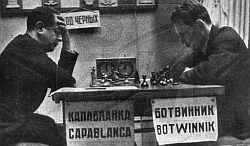
|
In Moscow 1935 the past and future world champions quickly drew their game |
The 'who else' statement sounds a bit too chauvinistic to me, especially since I am Dutch. After all, when Одноэтажная Америка was published the world champion was Max Euwe, the only Dutch world champion ever. His victory over Alekhine (the match was still underway when Ilf an Petrov were on the Normandie) created a chess fever in Holland which may have been equal to the one in Moscow in 1925. So the Declined Queen's Gambit players could easily have been Dutchmen. But to be fair, the Soviet-Union had indeed become a strong chess nation in the time between The Twelve Chairs and Одноэтажная Америка.
From 1001 день, или новая Шахерезада:
И начальники газонов и вазонов обнялись и решили на другой день вовсе не приходить, чтобы радикально отдохнуть от глупого соревнования, а в дальнейшем, не кривя душой, играть на службе в шахматы, обмениваясь последними анекдотами.
In Ilf's Notebooks we find the following chess aphorism:
Тот не шахматист, кто, проиграв партию, не заявляет, что у него было выигрышное положение.
This shows that Ilf understood about chess. For chess players this is almost a truism, though it may not be so obvious for outsiders.
References to Ilf and Petrov in the chess world
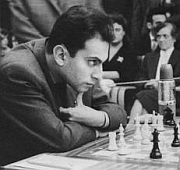
|
Mikhail Tal was famous for his hypnothizing stare |
Mikhail Tal was one of the most popular chess players ever. He became world champion in 1960 by beating Botvinnik in a match, but lost his title a year later in the return match. Tal was a master of attack, of sacrifices and dazzling combinations. He was truly the Great Combinator of chess, as witness this famous win against Botvinnik from their first match.
Tal is reputed to know the Ilf and Petrov novels virtually by heart and to be able to quote large passages literally. A fact is that he wrote his university thesis on 'the satire in The Twelve Chairs'.
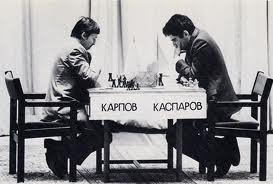
|
Sons of Lothar Schmid (above) and Lieutenant Schmidt (below) |
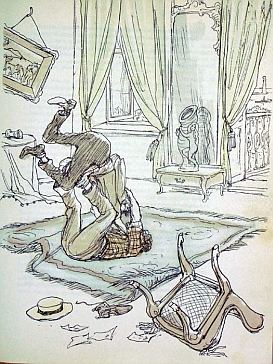
|
As you probably understand, Lothar Schmid is the name of this main arbiter.
I regularly play on the Free Internet Chess Society, an internet chess platform where you can play chess online. A few years ago I lost a game to some player (let us call him xxx) and I challenged him for a rematch. I received an automatic message: 'xxx is not open for match requests'. This is a setting which some players use. I typed 'rematch please' in the chat box, to which xxx answered: 'I klyuch ot kvartiry gde dengi lezhat?' We had not chatted before that, he apparently assumed that I was Russian (I play under the nickname of 'pavlik') and that being Russian I would of course know The Twelve Chairs.
On the Free Internet Chess Society there are players with the nicknames of OstapBender, ostapenko, OstapBenderbei, Ostapibragimovic, OstapBenderGM, Ostapkill, Ostap, ostapbeneder (one senses the despair of the player who found all Bender nicknames already taken - PJ), ostapko, ostapb, Ostapchuk (I like this one - PJ), ostapus, Bender, Kombinator, Ilf, Petrov, kisa.
 Chess players know that Ostap's visions for Vasyuki have for a large part become
reality in the Russian autonomous republic of Kalmykia, where President Kirsan
Ilyumzhinov, who is also president of the FIDE, the world chess federation, has
built a Chess City (officially called by the silly name of 'City- Chess')
as part of the Kalmykian capital Elista. There are buildings
with a chess-like design and a number of important chess events
have been organised there, including some world championship contests. Unfortunately
Chess City has not given anything to the regular inhabitants. In this respect
Bender's prediction ('мой проект гарантирует вашему городу неслыханный расцвет
производительных сил') certainly did not become true.
Chess players know that Ostap's visions for Vasyuki have for a large part become
reality in the Russian autonomous republic of Kalmykia, where President Kirsan
Ilyumzhinov, who is also president of the FIDE, the world chess federation, has
built a Chess City (officially called by the silly name of 'City- Chess')
as part of the Kalmykian capital Elista. There are buildings
with a chess-like design and a number of important chess events
have been organised there, including some world championship contests. Unfortunately
Chess City has not given anything to the regular inhabitants. In this respect
Bender's prediction ('мой проект гарантирует вашему городу неслыханный расцвет
производительных сил') certainly did not become true.There is an Ostap Bender statue in Chess City.
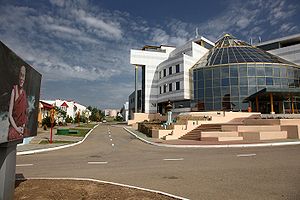
|
The main building of City Chess |
In 1967 a chess television programme was started in the Soviet-Union titled Клуб четырех коней, The Four Knights' Club. Straight from The Twelve Chairs, though not identified as such by Andrew Soltis in his book. The show lasted some ten years.
Former world champion Anatoly Karpov has written (together with A. Matsukevich) a manual called Find the Right Plan with Anatoly Karpov. Originally in Russian it is called Оценка позиции и план. Several chapters have at the end a small section 'Клуб-12' and/or 'Золотая дюжина этюдов'. One wonders...

Petrov playing chess
Document history of this page:
First online - 18/11/2010
Last minor changes 16/07/2012
Last major changes - 4/12/2010: small section about the Columbus Theatre (Zalkind and Malkin) added.
12/12/2010: Duz-Khotimirsky as model for Maestro Sudeykin.
23/01/2011: Lasker's bishop from b5 to c4 discovered.
19/2/2011: corrected two embarassing mistakes (about the years of the Lasker-Capablanca match and Alekhine's death)